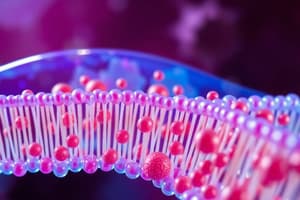Podcast
Questions and Answers
Which statement accurately describes the cell membrane's thickness?
Which statement accurately describes the cell membrane's thickness?
- About 5-7 nm
- Ranging from 10-12 nm
- Around 15-20 nm
- Approximately 7-9 nm (correct)
Which of the following is NOT a function of the cell membrane?
Which of the following is NOT a function of the cell membrane?
- Produces energy for cellular functions (correct)
- Maintains the cell's internal environment
- Separates the cytoplasm from the extracellular fluid
- Controls the distribution of ions
What is the primary component that forms the backbone of the cell membrane?
What is the primary component that forms the backbone of the cell membrane?
- Cholesterol
- Proteins
- Phospholipids (correct)
- Carbohydrates
Which of the following transports macromolecules into and out of the cell?
Which of the following transports macromolecules into and out of the cell?
What percentage of the cell membrane is made up of carbohydrates?
What percentage of the cell membrane is made up of carbohydrates?
What is the primary function of integral proteins in the cell membrane?
What is the primary function of integral proteins in the cell membrane?
Which statement correctly describes peripheral proteins?
Which statement correctly describes peripheral proteins?
Regarding ion channels, which type is characterized by being always open?
Regarding ion channels, which type is characterized by being always open?
What is the role of receptors in the cell membrane?
What is the role of receptors in the cell membrane?
Which channel type opens in response to changes in the cell membrane potential?
Which channel type opens in response to changes in the cell membrane potential?
Study Notes
Cell Membrane
- A very thin, elastic, semipermeable membrane (allowing some substances to pass through and preventing others) that surrounds the cell.
- Thickness: About 7-9.0 nm (70 - 90 Ao = Angstrom = 10-10 of meter).
- Separates the cytoplasm from the extracellular fluid (ECF).
- Maintains the cell's internal environment.
- Transports macromolecules into and out of the cell.
- Controls the distribution of ions (e.g., Na+, K+) in both the intracellular fluid (ICF) and ECF.
- Contains receptors for hormones and transmitter substances.
- Generates transmembrane membrane potentials.
Components of the Cell Membrane
- Lipids (42%): Form the basic structure or backbone of the cell membrane.
- Phospholipids
- Cholesterol
- Glycolipids
- Proteins (55%):
- Integral (intrinsic) Proteins: Bind to the hydrophobic center of lipids.
- Transmembrane proteins: Span the entire bilayer and act as:
- Channels: For diffusion of small ions.
- Carriers: Transport substances (e.g., glucose).
- Pumps: Actively transport ions.
- Receptors: Initiate intracellular reactions when activated.
- Present only on one side of the membrane: Act as enzymes (e.g., adenyl cyclase, which forms cyclic AMP from ATP).
- Transmembrane proteins: Span the entire bilayer and act as:
- Peripheral (extrinsic) Proteins: Bind to the hydrophilic polar heads of the lipids or to the integral proteins.
- Bind to the ICF surface of the membrane and contribute to the cytoskeleton.
- Bind to the ECF surface of the membrane and contribute to the glycocalyx or cell coat.
- Integral (intrinsic) Proteins: Bind to the hydrophobic center of lipids.
- Carbohydrates (3%): Contribute to the glycocalyx or cell coat.
Ion Channels
- Protein channels that allow passage of ions (e.g., Na+ ions) through the cell membrane.
- Types:
- Leak ion channels: Always open.
- Chemical-gated ion channels: Open when a chemical substance binds to its receptor.
- Voltage-gated ion channels: Open by changes in the cell membrane potential.
Transport Mechanisms through Cell Membrane
- The cell membrane controls the movement of substances across it.
- Movement can be passive or active.
Diffusion
- The movement of substances across the cell membrane down its electrochemical gradient due to the continuous random motion of its particles.
- Types:
- Simple diffusion: Movement of substances across the cell membrane down its electrochemical gradient by simple movement without the necessity of binding with carrier proteins.
- Facilitated diffusion: Movement of substances across the cell membrane down its electrochemical gradient, which needs the presence of carrier proteins.
- Osmosis: The passive flow of water across a semi-permeable membrane down a concentration gradient of water.
Active Transport
- The movement of substances across the cell membrane against its electrochemical gradient.
- Requires energy.
- Uses carrier proteins.
Vesicular Transport
- Mechanism by which large-sized substances can cross the cell membrane.
- Requires energy.
- Types:
- Endocytosis: Cellular uptake of material.
- Phagocytosis: Engulfing of solid particles (e.g., bacteria and dead tissues).
- Pinocytosis: Uptake of substances in solution (e.g., proteins).
- Receptor-mediated endocytosis: The uptake of specific substances that bind to receptors on the cell membrane.
- Exocytosis: Release of material from the cell into the extracellular environment.
- Endocytosis: Cellular uptake of material.
Summary
- The cell membrane provides structure and controls the movement of substances into and out of the cell.
- Ion channels are important for regulating ion movement across the cell membrane.
- Membrane transport can be passive (diffusion) or active (active transport and vesicular transport) and involves the use of carrier proteins.
- Vesicular transport is important for the movement of large molecules and particles.
Studying That Suits You
Use AI to generate personalized quizzes and flashcards to suit your learning preferences.
Related Documents
Description
Explore the essential components and functions of the cell membrane, including its semipermeable nature and the role of lipids and proteins. This quiz covers how the membrane maintains cellular homeostasis and regulates ion distribution. Test your understanding of this crucial aspect of cell biology.



